
Mastering the art of sketching from life is a crucial skill for any aspiring artist or designer. Whether you're capturing the essence of a bustling city street, the grace of a model in motion, or the intricate details of a still-life arrangement, the ability to accurately and expressively render what you see before you is a powerful tool in your creative arsenal. In this comprehensive guide, we will explore the best sketching techniques to help you elevate your observational drawing skills and create stunning, life-like sketches.
Observational Drawing
At the heart of sketching from life is the practice of observational drawing. This technique involves closely examining your subject matter and meticulously translating what you see onto the page. Begin by taking the time to truly observe your subject, noting the shapes, proportions, textures, and subtle nuances that make it unique. Pay attention to the interplay of light and shadow, and use your pencil to capture the play of highlights and shadows across the form.
As you draw, resist the urge to rely on your memory or preconceived notions of how the subject should look. Instead, let your eyes guide your hand, allowing the pencil to follow the contours and forms that you observe. This approach will help you create sketches that are true to life, with a level of detail and realism that captures the essence of your subject matter.
Gesture Sketching
Gesture sketching is a dynamic and expressive way to capture the energy and movement of a subject. Rather than focusing on precise details, this technique emphasizes the overall shape, flow, and rhythm of the subject. Start by quickly observing the key gestural lines and forms, then use bold, confident strokes to translate them onto the page.
Gesture sketching is particularly useful for capturing the dynamic poses of models, dancers, or athletes in motion. By keeping your pencil moving and your strokes loose and fluid, you can convey a sense of movement and vitality that static, detailed drawings often lack. This approach can also be a valuable tool for quickly capturing the essence of a scene or landscape, allowing you to record the world around you with a sense of spontaneity and energy.
Contour Line Drawing
Contour line drawing is a technique that emphasizes the outer edges and defining lines of a subject. Rather than focusing on shading or value, the goal is to create a continuous, unbroken line that follows the contours of the subject, tracing its shape and form.
This approach encourages you to slow down and really observe the subject, as you must carefully follow the edges and contours with your pencil. The resulting drawings often have a simple, elegant quality, with a focus on the essential shapes and forms that define the subject. Contour line drawings can be particularly effective for capturing the organic, flowing forms of the human figure, as well as the intricate details of still-life arrangements or architectural elements.
Value Studies
In addition to capturing the essential shapes and forms of a subject, skilled sketchers also understand the importance of value, or the relative lightness and darkness of tones. Value studies involve closely observing the interplay of light and shadow, and using a range of pencil strokes and shading techniques to accurately render the tonal values of the subject.
By focusing on value, you can create sketches that have a greater sense of depth, volume, and three-dimensionality. Experiment with a range of pencil techniques, from hatching and cross-hatching to smudging and blending, to capture the nuances of light and shadow across your subject. Pay close attention to the gradations and transitions between values, as this will help you create a sense of form and depth that brings your sketches to life.
Perspective Rendering
Accurately rendering perspective is a crucial skill for any sketcher working from life. Whether you're drawing a cityscape, a landscape, or an interior scene, understanding the principles of linear and atmospheric perspective will help you create sketches that have a strong sense of depth and spatial relationships.
Start by observing the converging lines and vanishing points that define the perspective of your subject. Use these as a guide to accurately position and scale the various elements within your sketch. Additionally, consider the effects of atmospheric perspective, which can cause distant objects to appear lighter, less detailed, and more hazy. By incorporating both linear and atmospheric perspective into your sketches, you can create a sense of depth and distance that helps to immerse the viewer in the scene.
Compositional Strategies
While the technical aspects of sketching from life are important, the overall composition of your drawing is also crucial to its success. Skilled sketchers understand the importance of thoughtful, intentional composition, and they use a range of strategies to create visually compelling and balanced drawings.
Consider the placement and framing of your subject within the page, using techniques like the rule of thirds or dynamic asymmetrical compositions to create a sense of visual interest and flow. Pay attention to the negative space around your subject, and use it to accentuate the positive forms and shapes. Experiment with different perspectives and vantage points, and be willing to adjust your composition as you go to achieve the desired effect.
By mastering these essential sketching techniques, you'll be well on your way to creating stunning, life-like drawings that capture the essence of the world around you. Whether you're sketching cityscapes, the human figure, or still-life arrangements, these tools will help you develop your observational skills, hone your technical abilities, and elevate your artistic expression. So grab your pencils, sharpen your focus, and get ready to create some truly captivating sketches from life.
 Writing TipsCreative WritingJournalingSketching TechniquesBuying GuidesPrivacy PolicyTerms And Conditions
Writing TipsCreative WritingJournalingSketching TechniquesBuying GuidesPrivacy PolicyTerms And Conditions
